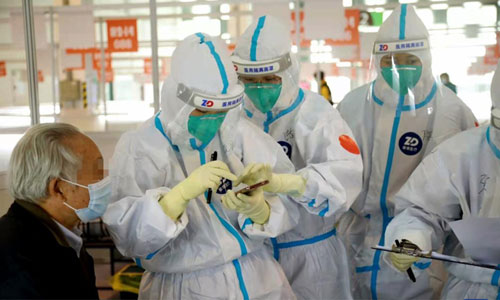Shanghai will seal off residential communities and suspend public transportation for mass nucleic testing for four days in its eastern half beginning on Monday, after the city registered 45 confirmed cases and 2,631 asymptomatic cases, the highest daily number of new cases in the national COVID-19 tally reported on Sunday.
In order to contain the epidemic spread and ensure the safety and health of the people, and achieve dynamic zero cases in a quick manner, based on the previous rounds of nucleic acid testing and experts’ assessments, the Shanghai municipal government decided to launch a fresh round of “partitioned” and “grid-based” nucleic acid testing, according to a notice released by the city government on late Sunday.
Mass nucleic acid testing in Shanghai will be launched in two stages alongside the Huangpu River, with communities in each half of the mega city about to be sealed off for four days, the notice read.
The notice read that areas including Pudong, Punan and neighboring areas including Fengxian, Jinshan and Chongming will be sealed off starting from Monday at 5 am to April 1 at 5 am. Residential communities in Puxi region then will be sealed off for four days starting from April 1 at 3 am to April 5 at 3 am.
During the period, residents should stay indoors and vehicles will be prohibited from going out of residential areas. Essentials for basic life will be delivered without contact. Public transport including buses, subways, taxis and ferries will stop operations.
Except for those companies that provide the city with basic necessities and operations, all the rest of the companies will adopt closed-loop operations or ask their employees to work at home when the region is sealed off. Residents who fail to take nucleic acid tests in the required time will have a yellow health code, the notice read.
Many local stores in Pudong extended their business hour till midnight on Sunday as local residents swarmed in to purchase daily necessities.
From March 1 to March 26, the total number of positive tests reported in Shanghai reached 12,513, according to data compiled by the municipal health authorities. Among Shanghai’s positive cases reported on Sunday, 27 confirmed and 2,363 asymptomatic cases were already in quarantine before testing positive.
Shanghai, with 16 districts and a population of nearly 24.9 million, was striving for dynamic zero with a combination of nucleic acid testing in key areas and antigen self-testing in non-key areas, which started on Saturday. More than 14 million residents in the city have completed the “rapid and convenient” test as of Saturday and some showed positive results.
Health experts noted that the move is a reference to Shenzhen as the city returned to normalcy after it sealed off communities, suspended public transportation and closed businesses for seven days. The “Shanghai, Shenzhen methods,” which both take a relatively shorter time to achieve the goal of mass testing and dynamic zero cases, can be viewed as a trial for future policies, experts noted.
Lu Hongzhou, head of the Third People’s Hospital of Shenzhen, told the Global Times on Sunday that it is a timely measure for Shanghai, as the virus has spread widely within the city, which will have a greater impact on the city’s economy if it goes on like this for a long time.
Jin Dongyan, a biomedical professor at the University of Hong Kong, told the Global Times on Sunday that the reasons why Shanghai shifted the anti-epidemic method to mass testing in two stages are because rounds of tests may prove the city has many more potential infections that have yet to be screened out, and antigen self-testing is not sensitive enough to screen out positive infections.
Conducting citywide nucleic acid testing and separating the city into two halves with the Huangpu River as a boundary is a good way to keep Shanghai from completely shutting down, said Lu. Rather than placing all residential communities under closed management, suspending public transportation and closing stores and businesses all at once, the “Shanghai method” will have a relatively smaller impact on the running of the city when half of the city keeps up work, while the other half is paused for testing, Lu said. — Xinhua










